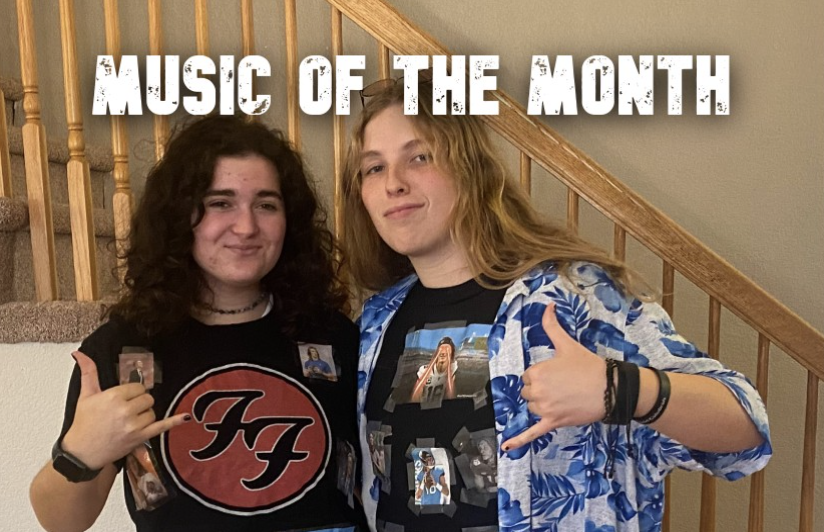Music of the Month: January
A look at our top songs for the month of January.
Cali and Brianna compile a list of their top songs each month and go in depth with them.
February 16, 2023
Happy January! We hope everyone had a solid start to the second semester and we are very excited to kick off this MOTM edition with tracks we’ve been obsessed with. As always, enjoy!
Cali’s picks:
“Bother” by Stone Sour, “Bother” (2002)
Originally written by Corey Taylor for his solo career, “Bother” became the debut single for Stone Sour, Taylor’s side project. The beautifully heart-wrenching ballad features mellow guitars, melancholy vocals, and an orchestral string section. Beginning with Jim Root’s evocative sliding riff, Taylor sets the mood of the piece with the apathetic line, “Wish I was too dead to cry, my self-affliction fades.” Taylor’s meaningful voice is heavy with emotion as he regularly changes volume, adding even more feeling to the moving number. The chorus transcends the euphoric ballad into a climactically harmonious symphony of beautiful sadness. The minimalist and dramatic nature of the number epitomizes a feeling of being on the brink of giving up, yet still experiencing a small flicker of hope. The second verse begins the same as the first, but gains momentum through the melodic pre-chorus that transitions flawlessly into the second reprise. Throughout the tune, Root shines on guitar with his triad-based staccato riffs, and his mellow, yet poignant guitar solo that follows the second chorus. After the third verse, the band falls into a pivotal third chorus riddled with the symphonic sounds of the orchestra, a multitude of guitar licks, and the tortured wails of Taylor that fade into the brief instrumental outro. Over the years, the song has become one of Stone Sour’s most popular songs, as well as an esteemed fan favorite. Although Taylor and Root are most famously known for their iconic metal band Slipknot, the slow nature of this track shows that anybody could have musical versatility.
“Texas Reznikoff” by Mitski, “Bury Me at Makeout Creek” (2014)
With a title referencing American poet Charles Reznikoff, Mitski begins her seminal third studio album “Bury Me at Makeout Creek,” with a dynamic, hopeful track that contrasts the more depressive themes of the album. Clocking in at just over two minutes, “Texas Reznikoff” begins with a swooping breeze and a tranquil acoustic guitar. Following the first few measures of sweet guitar, Mitski begins singing the first verse in her blissful and expressive voice. Mitski’s voice travels throughout the vocal spectrum, ranging from calm coos to thunderous cries. With no fluid structure, Mitski adopts an avant-garde song style, as well as unique vocal patterns throughout the entirety of the composition. The lyrics contain a story that reminisces on good times spent with a person she loved, as well as the drastic changes she made so that person would love her back. The first two verses remain in an acoustic, soft manner, when after a short instrumental interlude, the first line of the third verse, and a violent outburst of feedback, the song erupts into a powerful, angst-fueled ensemble. After this, Mitski’s vocals beautifully carry an essence of strength and persistence as she drags out many of her notes in the lines that follow. The outro begins as Mitski repeats the poetic, title-referencing line “You’re the breeze in my Austin nights,” Upon the third reiteration of this line, an eclectic instrumental segment takes over that contains garage-like electric guitars, many forms of percussion, and snappy acoustic guitars. Not only does this moody number create a riveting album opener, it gives a wide expanse into the mind of the genre-bending Mitski.
“I’d Like To Know” by Supergrass, “I Should Coco” (1995)
A fast-paced, musically all-over-the-place Britpop essential that features rollicking riffs, creative solos, and sporadic synth beats. As the opening track on the Oxford trio’s debut studio album, “I’d Like To Know” immerses the listener into the multi-genred world of Supergrass. Beginning with a drum count off by Danny Goffey and a fierce guitar glissando, the groovy number tells the tale of what an ideal day would look like, while wondering about where “all the strange ones go.” Taking the mic, Gaz Coombes begins singing in his distinct voice that adds to the overall kookiness of the ditty. Throughout the song, background vocals from Goffey and Mitch Quinn are prevalent, harmonizing with Coombes and bridging the gaps between the verses and choruses. The grunge-influenced guitar work mainly consists of bridged, staccato riffs that make up the synth-dominated verses and the driving choruses. Bassist Quinn shines in each chorus, as his quaint and declining basslines help transition into the short instrumental break between the second and third reprises. Following this last chorus, Goffey plays a rolling drumbeat that sends the band into a nearly two-minute outro that features rhythmic drumming, stadium-rock guitar soloing accompanied by fitting synth, and powerful riffs that eventually peak and abruptly cut off. Supergrass shows that they should be regarded as more than one-hit-wonders–due to the success of their song “Alright,” which was featured in the hit film 1995 “Clueless”– through the excellent instrumentation and danceability of this number that instantly brightens the listener’s mood.
“Deepfake” by Johnny Booth, “Deepfake” (2021)
Initially released as a single in 2021, “Deepfake” is a harsh, grinding track that talks about the hypocrisy and self-centeredness of Hollywood and celebrities. The New York hardcore group starts the composition off with a brutal guttural courtesy of Andrew Herman before adding the rolling double-bass drums and downtuned guitars. This calamitous intro is disrupted by a sharp harmonic squeal that sends the band into a calm breakdown before the storm of the verse shrouds the composition. These verses are fiery and riddled with Herman’s warped screams, the djent-like guitars, and Scott Owens’ pounding drums. Between each verse and chorus, the tune dives into a short instrumental break that showcases the musicianship of guitarists Adam Halpern and Ryan Strong, as well as Owens on drums. The informal choruses can be described as repetitive reprises that include the repetition of the scathing lines “Blinded by the camera/Deafened by the self-absorbed.” The first chorus fades directly into the second verse, but unlike the first, the tempo slightly slows before moving into the chaotic second chorus. Following an echoed vocal callout, the band begins a methodical, yet callous, breakdown that is gradually overshadowed by Herman’s wails. After the breakdown, the tune transitions into a feedback-filled outro that features melodic riffs and the repeated yells of “You were at fault but you never will say it,” until sealing the track closed with one final scream.
“Lazy Eye” by Silversun Pickups, “Carnavas” (2006)
An eclectic staple that serves as the seventh song on Silversun Pickups’ debut studio album, “Carnavas.” “Lazy Eye” is a mix of grunge, indie rock, and shoegaze that begins with a single clean guitar riff that morphs into a distorted lick as the band joins after the initial 15 seconds. Vocalist Brian Aubert begins singing in his whimsical and soft voice that perfectly blends the instruments and lyrics. The dreamy verses are filled with the beautifully mixed soloing and riffing guitars that change pace and volume multiple times throughout. With some musical reminiscence to the Smashing Pumpkins’ hit “1979,” the composition touches on the theme of finding true love after waiting for what seems like forever. Following the first verse, Aubert breaks into a lackadaisical and muted guitar solo that connects it to the hopeful second verse. After this, Aubert carries off into another relaxed solo that transitions into the dynamic bridge. The bridge continues the euphonious style of the song until halfway through as Aubert screams the last two words of the line “Everyone’s so focused clearly with such shine,” bringing the track into a whole new direction. The third verse takes on a heavier, more uppity, energy as the distorted guitars and bellowed yells ring through before going back to the calmer, more melodic style present earlier in the song. Following the soothing fourth verse, the band carries into a long instrumental break that highlights the musical prowesses of guitarists Aubert and Jack Kennedy as well as drummer Christopher Guanlao. To wrap up the quaint tune, Aubert repeats the first line of the song (“I’ve been waiting for this moment,”) as a subtle feedback note takes over, enveloping the track in silence. Released as the third single off of “Carnavas,” it faced much success, peaking at #5 on the Billboard Hot Modern Rocks Chart, causing “Carnavas” to reach #80 on the Billboard Hot 200 Chart for albums.
Brianna’s picks:
“Taste The Pain” by Red Hot Chili Peppers, “Mother’s Milk” (1989)
Full of energy and funk, Red Hot Chili Peppers (RHCP) begin this absolute banger by backmasking the chorus before transitioning into Flea’s funky bassline, Fishbone’s Philip “Fish” Fisher rolling drums, and John Frusciante’s sustained, screeching guitar. Joining the established band at 19 years old, “Taste The Pain” was the very first song that Frusciante recorded with the group in ‘89, a phenomenal introduction of Frusciante’s Hendrix-inspired styles and exceptional talents. When Anthony Keidis enters with his rapped lyrics, the listener is immersed in the essence of RHCP: funk, vitality, rap-style vocals, phenomenal harmonies, advanced instrumentation, prominent basslines, expert drum fills, complex solo, and chords ⎯ all of this forging “Taste The Pain.” Writing is credited to Kiedis, Flea, Frusciante, and drummer D.H. Peligro who also co-wrote two other tracks from “Mother’s Milk.” Flea’s rubbery bass wandering unrestrained highly contrasts Frusciante’s jagged and sharp Stratocaster. “Taste The Pain” spotlights Flea’s multi-instrumentalist talents through his trumpet solo and additional musician Dave Coleman on the cello, which is most prominent in the last verse, supporting the trumpet, the easing bridge, and outro. Alongside the bass, Coleman’s cello provides a warm variance against Frusciante’s staccato playing. An alternate version for the 1989 romantic comedy film “Say Anything” was released prior to the studio album’s track, featuring a longer intro with varied effects from the album version and lengthened intermissions of solo work from each counterpart. Coincidently, Kiedis’ girlfriend at the time, Ione Skye, was the female lead in the film. The “Say Anything” version offers more stylistic choices and effects than the studio cut. Nonetheless, the “Mother’s Milk” track still showcases the band’s talents of demonstrating various tones while sustaining energy through each section of the song.
“Dream Brother” by Jeff Buckley, “Grace” (1994)
The all-around transcending discography of Jeff Buckley is evident in all of his tracks; but is especially notable in the last track on the original release of Buckley’s debut and only studio album. Buckley exceeds and surpasses a state of transcendence with his vocals alone ⎯ enter a group of musicians that excel in musical composition to accompany him. Buckley exhibits his other musical talents by also playing the organ and tabla, an instrument a part of the drum and percussion family and originated in the Indian subcontinent. Buckley is joined by Misha Masud on the tabla. Drummer Matt Johnson also contributes to the vibraphone, a percussion instrument with a warm and mellow tone. The atmospheric intro begins with overlapping string bending on a shimmering guitar ⎯ most likely his 1983 Telecaster. Adding to the bare intro, an additional guitar track is introduced and remains prominent throughout the verses. The instrument company of the track is slowly incorporated in short increments towards the end of the intro and later contribute to a louder effect within the chorus and instrumental interlude. The rhythmic drumming of Johnson contributes to the build up through the chorus leading to the instrumental break. Buckley’s vocalise is ghostly and captivating prior to the lyric hiatus and seamlessly blends into the sustained organ. The haunting but gorgeous interlude includes layered counterparts consisting of shattering cymbals, the guitar tone evident from the verses, the organ, a prominent bassline, and precise drum fills. There is a story being told through the instruments alone by contrasting dynamics such as peace, tension, force, relief, and conflict that pushes the narrative told through Buckley’s lyrics. Allegedly written on account to Chris Dowd, a former member of ska punk-rock band Fishbone and long-time friend of Buckley. “Dream Brother” is also paralleled to Buckley’s relationship with his father, Tim Buckley (also a late musician), with the potential events of Dowd walking out on his family. Deriving from a few genres such as neo-psychedelia and art rock (taking some form from avant-garde), space rock fits the best description of the track due to the characteristics of lengthy tracks, incomparable and hypnotic effects, and the layered instrumentation to cater to these qualities. Buckley closes the ballad with the line “Asleep in the sand with the ocean washing over,” adding further to the haunting ambience of the track through narration in addition to the instrumentation; foreshadowing his tragic passing in a drowning accident. This is an additional connotation seen in Buckley’s discography also evidenced in the fifth track “So Real” with the lyric, “And I couldn’t awake from the nightmare, that sucked me in and pulled me under.” The stirring aura of “Dream Brother” is overwhelming and preeminent with the group’s euphonious composition.
“Tremor Christ” by Pearl Jam, “Vitalogy” (1994)
As the fourth track on Pearl Jam’s third studio album, “Tremor Christ” is written in short yet effective lines alongside the prowess of the band. Recorded on a dark Louisiana night, the members from Pearl Jam delve into a marching beat that contrasts their customary style ⎯ especially in reference to Eddie Vedder’s distinct vocal tone and incoherent ramblings. The track arises with a two channel split between a dry, rhythmic guitar and incorporates the bass and brighter chords of an additional guitar. Mike McCready, the slide guitarist of the track, additionally incorporates his talents on the mellotron, a electro-mechanical keyboard that allows a player to imitate a variety of instruments and sounds. “Tremor Christ” includes three layered guitars from McCready, Vedder, and Stone Gossard. To contrast the brittle guitars, Jeff Ament plays a round, prominent bass line throughout the track’s entirety. Vedder emits the hardest hitting vocals on the band’s third record. With genius lyrical progression, the track evolves into a climax with structured chaos of the instruments. Succeeding the forcible interlude, Pearl Jam effortlessly bleeds into a mellow outro that resembles the foundation in the intro. In an interview following the release of the album, Gossard describes that ‘“Tremor Christ” seemed to write itself. It was just a riff-and-a-half, basically. On a muggy, beautiful New Orleans afternoon we came into a very cool studio and it poured out … [It was] very spontaneous, but with a simple yet indescribably beautiful vibe … ”
“Metabolism” by The Strokes, “Angles” (2011)
A vastly underrated track from The Strokes’ fourth studio album, “Metabolism” erupts into a catchy, rhythmic tempo of 162 beats per minute. Fabrizio Moretti syncopated drum triplets throughout the track uplifts the rhythmic playing of both guitar players, Nick Valensi and Albert Hammond Jr., and the bass played by Nikolai Frature, by adding additional texture to the track. Upon the entrance of Julian Casablancas’ anxious and aching lyrics, Fraiture omits his resonant bassline for the first half of the intro verse. Through each section of the track, Fraiture accompanies one of the guitarists, Nick Valensi, in the intro before the brief cessation. Casablancas displays his advanced sustained notes through the hard hitting chorus and melodramatic verses. His lyrics are simplistic, yet hold a lot of weight that supports the anxious tone alongside frantic instrumentation. Written by Casablancas, Valensi, and Moretti, “Metabolism” is among a list of 10 songs that have never been performed live by The Strokes. This immensely underappreciated track balances a contrast between a moody atmosphere with a danceable beat. Accompanied by the band, Casablancas ends the track with a climbing, raging falsetto contrasting the intro verse of raspy tonality, before abruptly closing the penultimate song to the album.
“She Hates Me” by Puddle of Mudd, “Come Clean” (2001)
Opening the sixth track with a single guitar with a catchy riff, “She Hates Me” hooks the listener with Wes Scantlin’s memorable lyricism. Sharing chords and melodies of “Summer Nights” from the musical “Grease,” providing the perfect irony between resentment in “She Hates Me” and reminisce in “Summer Nights.” Although, similarities can still be drawn between the two. Following the first verse, the rest of the band joins, adding more tension to the already transparent lyrics. Ironically, Scantlin includes upbeat compositions through the instrumentation and vocals about his ex-girlfriend’s bitterness. Additionally with the message behind the lyrics, the quality of Scantlin’s vocals are clear and coherent ⎯ even against the increased instrumental aggression after the third verse. Puddle of Mudd brings the track to a close with studio chatter and distorted guitar chords of the non-lexical vocables.




